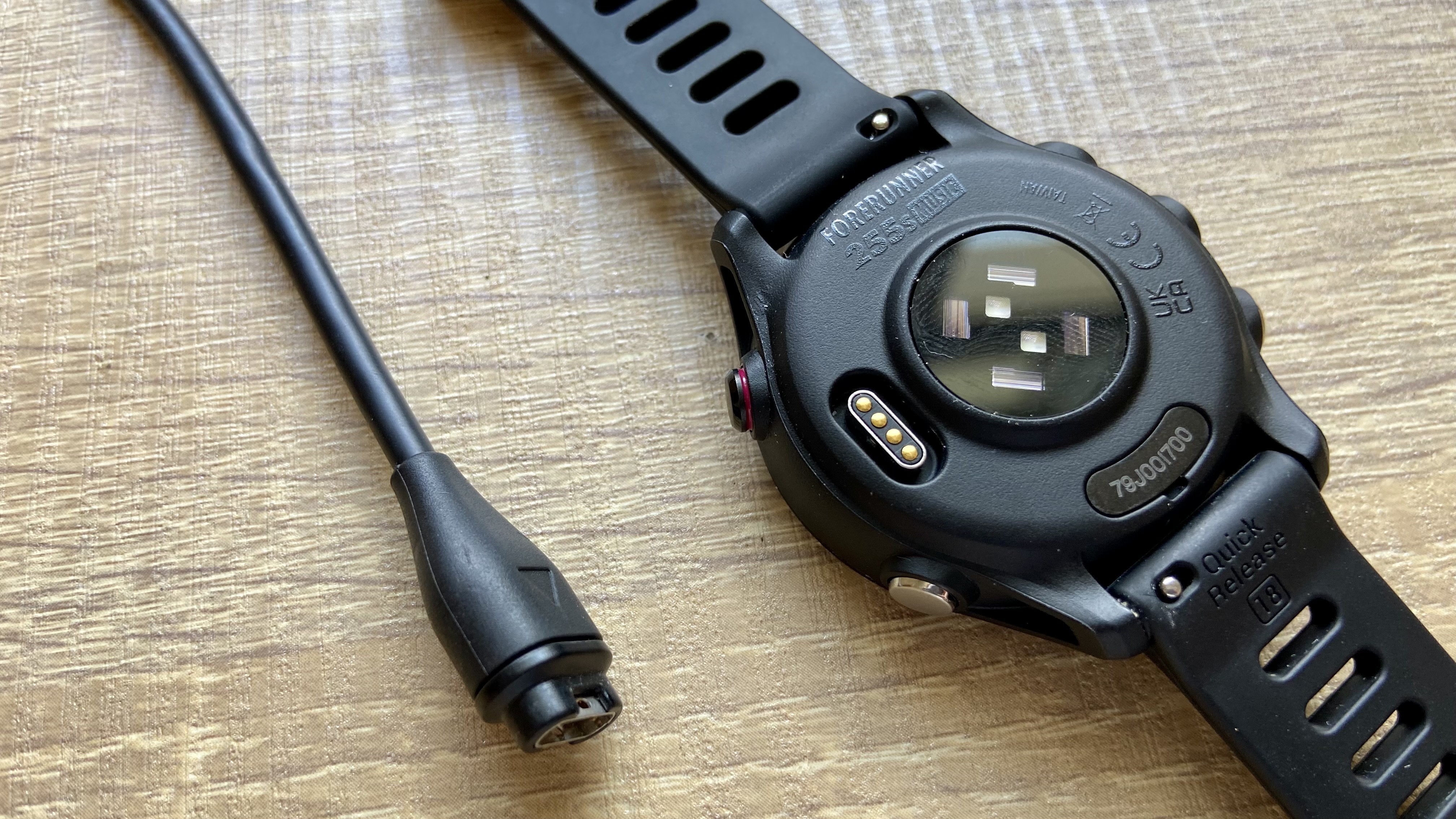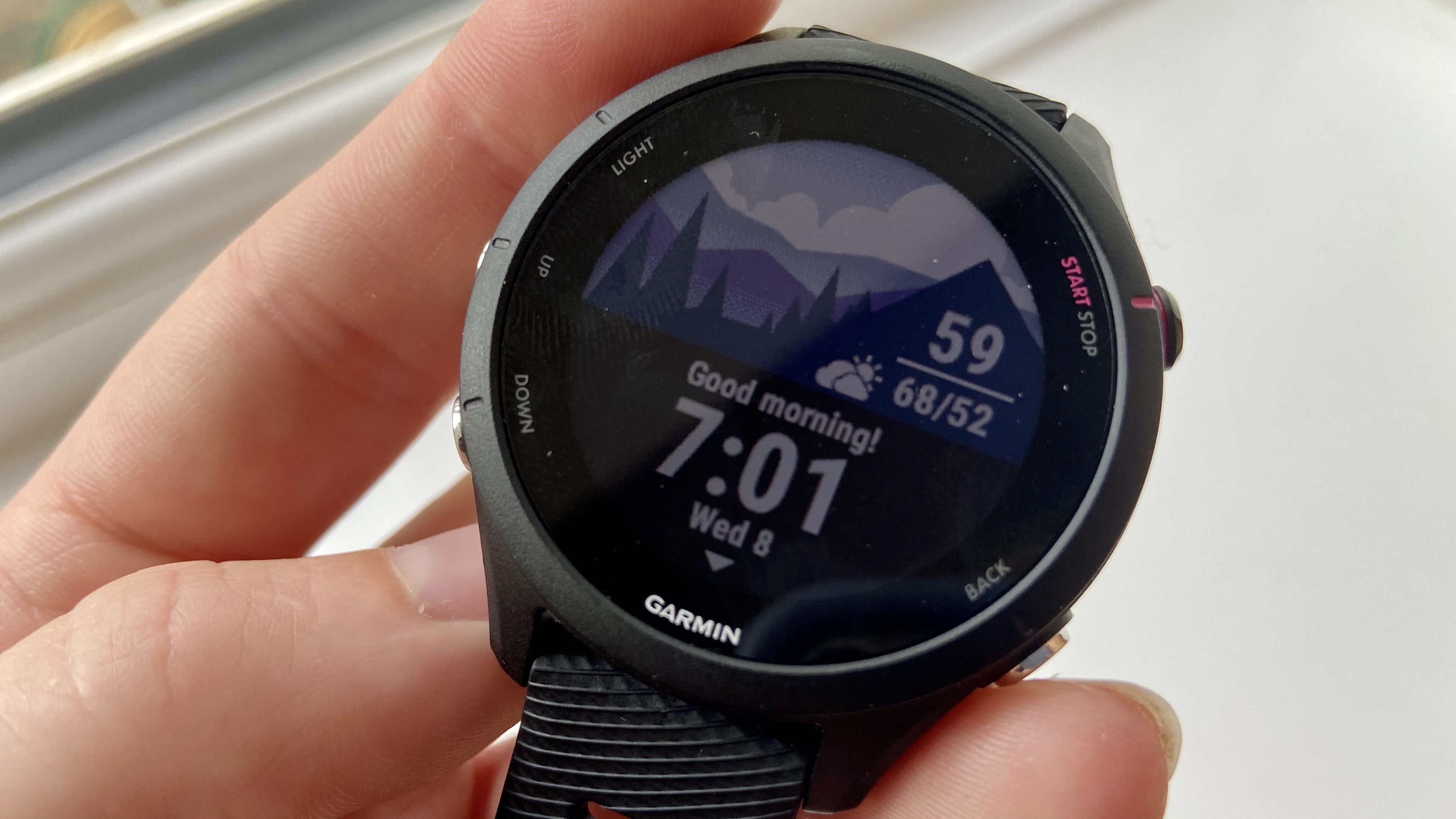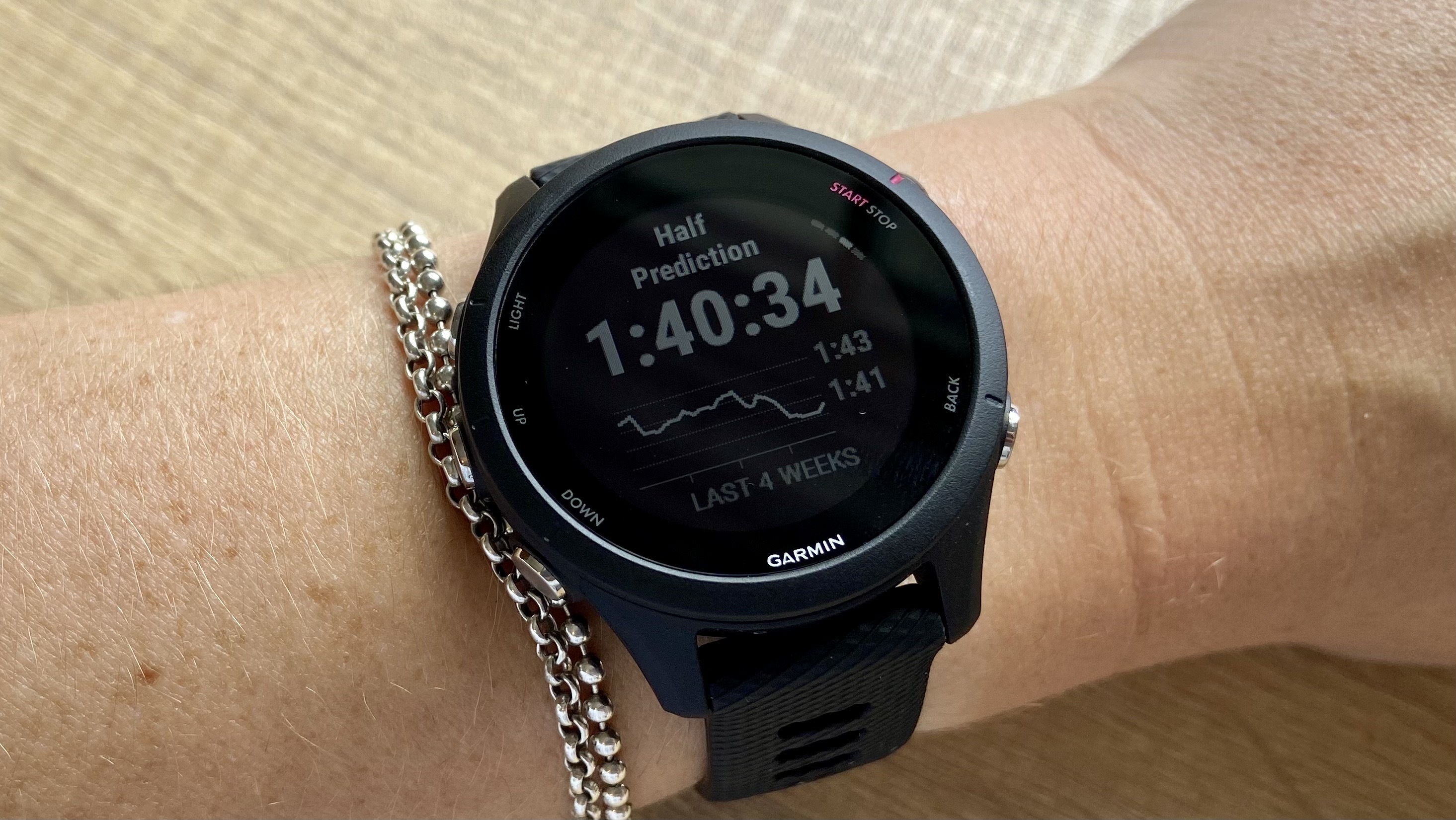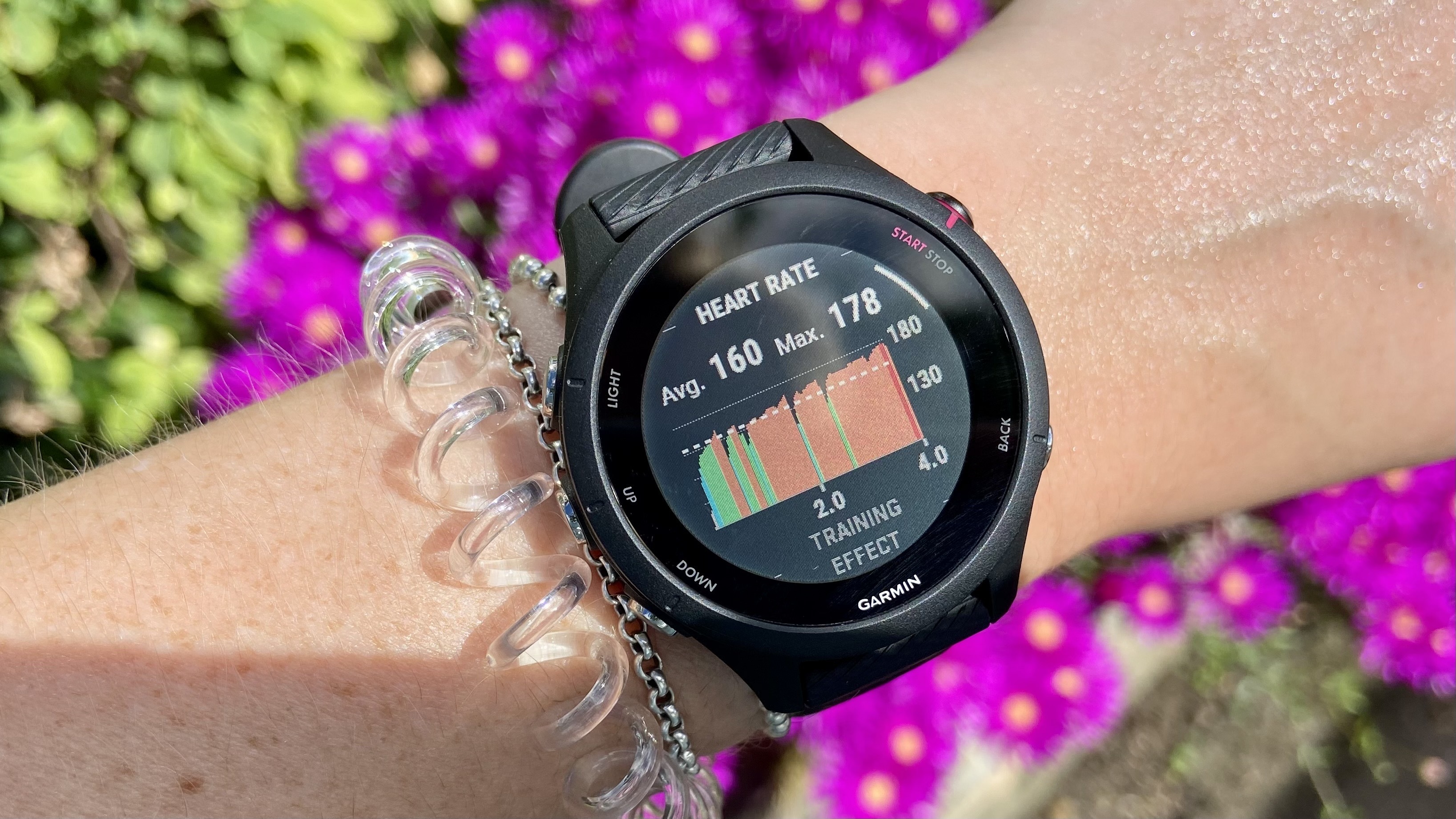Tom's Guide Verdict
Get the Garmin Forerunner 255 if you’re looking for a midrange running watch that won’t disappoint.
Pros
- +
Two sizes available
- +
Accurate GPS
- +
Multisport/triathlonn modes
- +
Two variants — music and nonmusic
- +
Improved battery life
- +
Garmin Elevate V4 sensor
Cons
- -
No touchscreen
- -
Lacks Garmin's Training Readiness score
Why you can trust Tom's Guide
It’s hard to improve on an already great running watch, so when Garmin announced the Forerunner 255, it was a case of finding out what’s new, and whether it was worth it. The answer is a big yes, in a small package. Garmin has packed a lot of new features into the Garmin Forerunner 255, and I’ve been putting it to the test to find out more.
Display Size: 1.1 inches (255S) and 1.3 inches
Resolution: 218 x 218 (255S) and 260 x 260
Weight: 39g (255S) and 49g
Water resistance: 5 ATM
GPS Battery life: 6.5 hours w/music / 30 hours w/out music
Connectivity: Wi-Fi, Bluetooth, ANT+
Music storage: Up to 500 songs
I’ve loved the smaller 42mm watch face (the Forerunner 255 comes in two sizes — 42mm and 46mm) and the ability to load music onto my watch and leave my phone at home. (The watch comes in two variants — with music, and without.). It’s also now got multisport profiles, upgrading the Forerunner 255 from a running watch to a watch that could get you through your training for a triathlon.
How does the Forerunner 255 compare to some of the other best Garmin watches? Read my full Garmin Forerunner 255 review below to find out more.
Garmin Forerunner 255 review: Price and availability
The Garmin Forerunner 255 comes in two different sizes — a 42mm (the Forerunner 255S) and a 46mm, both cost the same. As mentioned above, the Forerunner 255 also comes with the option to store music, or not. The Forerunner 255 without music costs $349/£299, and the Forerunner 255 Music costs $399/£349. This is slightly more expensive than the Forerunner 245, which hit the market at $299 without music, and $349 with music, but as you’ll read below, there are some more high-tech features on this watch that, in my opinion, make it worth the extra $50. Keep an eye on our Garmin coupon codes page too, and you might find a special offer that brings the price down slightly.
The watch is available in a number of different colorways, depending on the watch size you choose and whether or not you opt to be able to store music on the watch. You can buy the Forerunner 255 in black, white, tidal blue, slate gray, light pink and powder gray.
As with other watches in the Forerunner range, you can also swap the strap out with Garmin’s Quick Release bands to use a leather or metal strap on the watch.

Garmin Forerunner 255 review: Design
The design of the Forerunner 255 remains largely unchanged, aside from the fact I was testing the smaller version of the watch, which I loved. While the new Fenix 7 and Forerunner 955 have the addition of a touchscreen, the Forerunner 255 is still controlled using five buttons — three on the left and two on the right. I’d argue that the lack of a touchscreen isn’t all that much of a loss, as the touchscreen is automatically turned off when you’re actually exercising using the watch. Plus, anyone who has ever tried to swipe with a sweaty finger on a touchscreen will know they’re not often worth the price tag.
Get instant access to breaking news, the hottest reviews, great deals and helpful tips.
Like other Garmin watches, the entire data screen is customizable, and like Garmin’s newer watches, you’re now able to tweak everything from the Garmin Connect app, as well as on the watch.
As someone who has been running with a Garmin wearable for the past decade, I really appreciate this update from Garmin — being able to swap and add data fields on my phone is far less fiddly, especially when I’m heading out the door in a rush pre-training session.

Both the Forerunner 255S and the Forerunner 255 have a color MIP display that we found easy to read in all conditions, even in direct sunlight. On the smaller Forerunner 255S, the watch has a 1.1-inch display, whereas the 46mm Forerunner 255 has a 1.3-inch diameter.
The larger of the two watches also has a higher resolution than the Forerunner 245 — the Forerunner 255 has a 260 x 260 resolution compared to the Forerunner 245’s 240 x 240 pixel resolution. It’s not a difference you’d really notice unless staring at the two watches side-by-side (welcome to my world), but the screen on the newer watch definitely looks a little brighter and more colorful.
Garmin Forerunner 255 review: Battery life
Garmin has improved the battery life of the Forerunner 255 compared to its predecessor. The Forerunner 255 has a daily battery life of 14 days (this is double the Forerunner 245’s seven-day battery life) and a GPS battery life of 30 hours (an improvement on the Forerunner 245’s 25 hours).
During testing, I found these timings to be pretty accurate (I turned Pulse Ox tracking to only be on at night and turned smartphone notifications off while testing), and the watch went from dead to fully charged in a couple of hours.
Garmin Forerunner 255 review: Health features
Here’s where it gets interesting. The Forerunner 255 has inherited some of the more advanced health features usually reserved for Garmin’s more expensive running watches. The watch has Garmin’s latest Elevate V4 sensor — the green light records heart rate, the red light records blood oxygen levels (referred to as Pulse Ox on the watch). This sensor is used to calculate breathing rate, HRV, and stress.

Like the previous Forerunner 245, the Forerunner 255 automatically tracks in-depth sleep data, but new to the watch is the Morning Report feature, which gives you a snapshot into how well you slept, how hard you’ve been training, and a look at the weather for the day ahead. The Morning Report stays on the screen until you dismiss it, which I appreciate.
It’s important to differentiate between the Morning Report and Garmin’s Training Readiness score, which is available on the more expensive watches in the line, such as the Fenix 7 and the newly launched Forerunner 955. The Training Readiness score gives you an idea of how hard you should train that day, whereas the Body Battey score, which is available on the Forerunner 255, is a general snapshot of your health.
Either way, the Morning Report is a nice extra, plus you can customize what data you want to see in the report.

The Forerunner 255 also includes Garmin’s Health Snapshot feature, which was first introduced on the Garmin Venu 2 Plus. This is a one-off, two-minute measurement, that tracks your heart rate, blood oxygen level, stress, respiration rate, and heart rate variability (HRV). The idea is you do this recording regularly, ideally at a similar time of day, to gain an insight into how things trend for you health-wise. You get a summary of your stats after two minutes, and you can view these on the Garmin Connect app, as well as export it into a PDF.
Like most other Garmin watches, you also have the ability to track your periods, and hydration levels in the Garmin Connect app.
Garmin Forerunner 255 review: Running and sports features
Of course, one of the main reasons you buy a sports watch is to track sports. The Forerunner 255 has everything you’d expect from the Forerunner line — there’s multiple sports modes available: Run, Track Run, Treadmill, Bike, Bike Indoor, Pool Swim, Open Water Swim, Triathlon, Multisport (custom), Ultra Run, Virtual Run, Indoor Track, Trail Run, eBike, MTB, eMTB, Health Snapshot, Hike, Ski, Snowboard, XC Classic Ski, SUP, Row, Row Indoor, Walk, Strength, Cardio, HIIT, Yoga, Pilates Elliptical, Stair Stepper, Clocks, Floor Climb and Other. You can tweak the data screens for each sports profile on the watch and the Garmin Connect app.
From a fitness perfective, the Forerunner 255 has suggested workouts, as well as the new race calendar and race countdown widgets, which can help you prepare for a big effort. There’s also a new race prediction widget, which gives you an estimated finish time for the marathon, half marathon, 10K and 5K distance.
Garmin has also added the ‘Up Ahead’ feature (which allows you to see predefined markers such as aide stations and climbs in a race) and the race day specific performance prediction (which allows you to see if you’re getting faster or slower during a race) to the Forerunner 255.

During testing, I ran with the Forerunner 255 on one wrist and the Forerunner 955 on the other. I found the GPS to be extremely accurate on the cheaper running watch, and at the end of my run, the GPS maps were almost identical between the two. Impressive, when the Forerunner 255 is $100 cheaper.
Another huge difference between the Forerunner 255 and its predecessor is the addition of triathlon and multisport activity profiles. Until now, the ability to track brick sessions and triathlons has been reserved for more expensive watches in the Forerunner range.

Finally, Garmin has added its new Acute Load feature to the Forerunner 255. Slightly different to the seven-day load feature, it updates faster, so if you ran a hard race five days ago, the load will be dropping as time passes as you’re more likely to be recovering. The idea behind this feature is to prevent that dreaded Unproductive’ Training Status a week after a hard effort.
Garmin Forerunner 255 review: Smartwatch features
These days, running watches are designed to be worn 24/7, rather than just on the run, and over the past few years, we’ve seen brands adding smartwatch features to fitness watches. The Forerunner 255 is no exception and allows you to see smartphone notifications from your phone on the watch, although you can’t respond to messages right now. The Forerunner 255 also has Garmin Pay contactless payments, which allow you to keep your phone in your pocket when commuting.

What’s more, the Forerunner 255 Music version of the watch allows you to download up to 500 songs and playlists from Spotify or Deezer, which again, allows you to leave your phone at home on the run. During testing, it took a matter of seconds to load a couple of episodes of my favorite podcast onto the watch. I also was able to connect my Powerbeats Pro via Bluetooth, and head out phone-free.
I would say, however, that as a female runner I rarely run without my phone as I always carry it from a safety perspective, however, I’d probably use this feature in the gym. If like me, you’re unlikely to ever load music onto your watch, I’d save yourself $50 and buy the music-free Forerunner 255.
Garmin Forerunner 255 review: Verdict
This is a fantastic running watch, that is a great buy for all levels of runner. In fact, after running with the Forerunner 255 for the past few weeks, I’m in no hurry to swap back to my Garmin Fenix 7. The smaller, lighter watch has everything you need from a running watch and more.
At $349, the Forerunner 255 is around the same price point as the Apple Watch Series 7, but if you’re looking for a watch to do some proper training with, there’s absolutely no competition in my eyes — the Forerunner 255 is superior from a fitness tracking standpoint, and has a far better battery life than the Apple Watch.
If you’re a Garmin fan on a budget, the Forerunner 55 is also a fantastic running watch at a cheaper price point. If you already have the Forerunner 235 or 245, I’d say the new features make this worth the upgrade.

Jane McGuire is Tom's Guide's Fitness editor, which means she looks after everything fitness related - from running gear to yoga mats. An avid runner, Jane has tested and reviewed fitness products for the past five years, so knows what to look for when finding a good running watch or a pair of shorts with pockets big enough for your smartphone. When she's not pounding the pavements, you'll find Jane striding round the Surrey Hills, taking far too many photos of her puppy.

